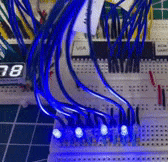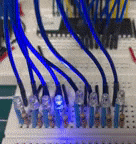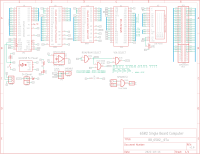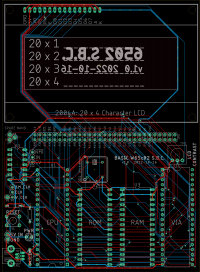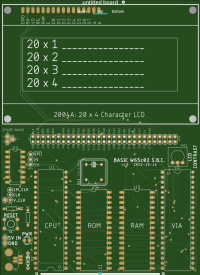|
Part 3: VIA (Versatile Interface Adaptor) Testing |
|
|
(CLICK TO ENLARGE)
VIA Wired into BB 6502 Assembly 6502 Binary Bus Capture Video: Alternating LEDs
6502 Assembly Video: Cylon LEDs
Eagle: Schematic Eagle: Board Layout Gerber Viewer: PCB Layout
|
What is a VIA? The W65C22 versatile interface adapter (VIA) is an input/output device for use with the 65xx series microprocessor family. We'll use most of the I/O as output and some as input.
Address Map When a 6502 machine language/assembly language instruction is sent to any address less than $8000, it is considered to be for the RAM, VIA, ACIA/UART, etc. and not for the ROM ($8000 to $FFFF). In our ROM/RAM select logic in the schematic, pins A15 low, A14 high and A13 high will choose any address between $6000 and $7FFF . With the VIA's RS0 to RS3 pins connected to A0 to A3, respectively, the specific addresses will be $6000 to $600F. Because our address selection logic is very simple, a lot of addresses will be unused but that's fine for our initial design; we'll refine the addressing later. The top left adjacent screenshot shows the labeled leads from the VIA to the buses. The versatile interface adaptor contains two banks of 8 addressable pins. Bank B will be for the 4x20 LCD data lines and Bank A will be for its control lines like E, R/W and RS. For our initial testing purposes, we'll wire 8 LEDs from PB7 to PB0.
Testing the VIA We performed the following: - wired the VIA into the BB - wrote the 6502 Assembly code using our fave editor - assembled the code into a 6502 machine language binary using DASM (dasmj.bat filename) - displayed the machine language code using HxD - burned the binary into the ROM using our MiniPro programmer - tested the output by capturing (using an Arduino Mega2560) the 6502's boot and code execution - video'd the LEDs alternating between the 0x55 and 0xAA patterns You can see all of this in the top five screenshots (click to enlarge).
After you have tried out the first program testVIA.asm, try testVIA_Cylon.asm which is demonstrated in the middle two screenshots. |
